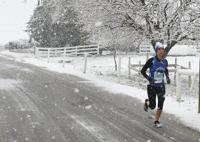While gardens may seem stark and colorless this time of year, there is indeed life within and beneath the winter landscape. Let’s take a look at the beneficial insects that might be using your garden as a winter resting spot.
Butterflies and moths
Most of us probably envision the monarch butterfly migrating to warmer climes in Mexico to wait out the winter, but the vast majority of butterflies found in Pennsylvania survive the winter in our backyards. Mourning cloak, comma and question mark butterflies find refuge between leaves or under bark and spend the winter as winged adults. A compound in their “blood” prevents it from freezing.
Butterflies in the swallowtail family overwinter as chrysalises underground, and likewise hawk and cecropia moths nestle within cocoons below the surface. Most of our nonmigrating butterflies and moths overwinter as caterpillars, protected by fallen leaves and the remains of summer perennials.
Bees
There are over 450 species of native bees in Pennsylvania and, unlike nonnative honeybees, they do not live in hives. Native bees overwinter in the top inch or two of soil, in hollow stems and in cavities in wood. These are some of the first pollinators to emerge in spring to coincide with the flowering of fruit trees.
Ladybugs
Voracious predators of aphids, native ladybug beetles overwinter under rocks and leaves and in hollow logs.
(Nonnative ladybug species are the ones that tend to seek refuge in our homes in winter!)
Fireflies
Fireflies, or lightning bugs, spend the winter in damp soil as wingless larvae. Called “glowworms” because of the radiance emitted from their abdomens, firefly larvae devour garden pests such as cutworms, snails and slugs.
How can you help overwintering insects?
The most important step you can take to encourage beneficial insects is to delay garden clean up until spring. Exactly when to clean up is the subject of some debate. Since spring weather fluctuates, bloom times of trees can help guide this decision.
Some native bees will emerge when plum trees are blooming in early spring, while others are programmed to emerge when apple trees are blooming, usually around the end of April.
Other insects do not emerge until June. Leaving natural leaf cover in a portion of your landscape is the best way to accommodate these insects.
• Leave some areas unmulched. A heavy layer of mulch is detrimental to insects that burrow underground. A layer of compost will not impede them, but bare soil is most beneficial.
• Use pesticides sparingly. Insecticides, including organic ones, can still harm both pest and beneficial insects. Even if you do not use pesticides in your garden beds, lawn pesticides will impact beneficial insects, especially firefly larvae.
As we look forward to spring, remember that a healthy garden requires year-round planning.
For more on winter garden projects, visit the Lancaster County Master Gardeners webpage, bit.ly/LancMasterGardener.
Lois Miklas is the coordinator of the Penn State Master Gardener Program in Lancaster County.

![Here are some botany lessons you can learn from poinsettias [Master Gardener column]](https://bloximages.newyork1.vip.townnews.com/lancasteronline.com/content/tncms/assets/v3/editorial/7/75/775da018-44e1-11eb-b652-f3061c0ee091/5fe2d878990e6.image.jpg?resize=200%2C133)
![Gift ideas for the gardeners in your life [Master Gardener column]](https://bloximages.newyork1.vip.townnews.com/lancasteronline.com/content/tncms/assets/v3/editorial/e/62/e628f74a-3feb-11eb-ad66-5ffad41b34a9/5fda875a57874.image.jpg?resize=200%2C133)
![5 steps to a more environmentally friendly garden [Master Gardener column]](https://bloximages.newyork1.vip.townnews.com/lancasteronline.com/content/tncms/assets/v3/editorial/6/35/635216c2-f8a5-11ea-929c-07b7e597a70d/5f62f2626c2a6.image.jpg?crop=1220%2C832%2C23%2C560&resize=200%2C136&order=crop%2Cresize)

![A road map for minestrone, a big hearty soup that invites improv and adaptation [Stay-Put Cooking]](https://bloximages.newyork1.vip.townnews.com/lancasteronline.com/content/tncms/assets/v3/editorial/6/5e/65ec0510-5745-11eb-8fac-3b190306460a/6001b360116dd.image.jpg?resize=200%2C178)

:max_bytes(150000):strip_icc()/house-cleaning-schedule-for-every-day-3129149-06-b23eacd9ef3a41fc833c68e095b34c72.jpg)



More Stories
How to Tackle a Leaking Tap without a Plumber
What Home Herb Garden is Right For You?
Hot Selling Products Wooden Duck Wholesale This Week